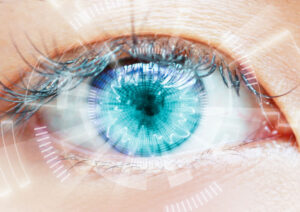
Amblyopia in adults and children is common. However, this type of misalignment also known as “lazy eye” can take your vision, and harm your self-esteem. Caused by a breakdown in essential muscle, and nerve tissue associated with the eyes, amblyopia can also result from a loss of connectivity between the brain and eyes. When the symptoms of amblyopia start to show in adults one eye becomes lazy or has a tendency to wander inward or outward independently of the other eye. This type of unpredictable eye movement is also common in children. Amblyopia in children usually develops during the early stages of life (from birth to 7 years of age).
While the reasons for developing a lazy eye can include genetics, overuse, or strain, the most common symptoms of amblyopia usually occur due to damage of essential muscle, and nerve tissues. Amblyopia in adults and children usually affects only one eye, and for this reason, many people simply refer to amblyopia as “lazy eye.” Children are commonly affected by amblyopia as it is the leading cause of vision loss in children thus, prevention is the key to reducing the risk of lazy eye.
If you or your child has symptoms of lazy eye – never fear. Regardless of what causes lazy eye, there is a range of symptoms that can be treated easily. If you require amblyopia treatment or know someone who does, learning more about the many amblyopia causes can help you get the right type of therapy.
How Do You Get a Lazy Eye?
There are many different amblyopia causes for adults, and children that can lead to a loss of balance in the eyes. Strong eye muscles and regular vision exercises can help you maintain good eyesight over time. However, children can also develop amblyopia early in life. A common childhood health problem, amblyopia (lazy eye) usually responds well to conventional therapies and early treatment. Usually, people try to avoid amblyopia by knowing exactly, “How do you get a lazy eye?”
Here is a list of the 3 most common reasons for lazy eye (amblyopia causes):
- Muscle Imbalance
One of the most common causes of lazy eye is known as strabismus amblyopia or misalignment. This type of imbalance in the eyes begins in the muscles that position your eyes. Back where those small muscles and nerve fibers work together you may experience a loss of balance that leads to crossing, turning inward, or outward, or even a loss of function.
- Differences in Vision
The health of your eyes is so important. Without healthy, balanced eyesight you may even lose part or all of your vision. However, you can always keep a lookout for the signs of developing a lazy eye by testing your vision at home for sharpness. If you notice a significant difference in your eyesight, sharpness, or eye movement, talk to your eye doctor. You may be showing the signs of refractive amblyopia if you have differences between each eye in an existing prescription. Thus, you may need to frequently check for vision changes to prevent lazy eye symptoms.
- Deprivation
If you notice new eye problems or have had issues with your vision in the past, you may have developed amblyopia. This is common however, in its infancy urgent treatment can be used to stop a loss of your vision. While this is the most severe kind of eye problem, deprivation amblyopia can affect one, or both eyes prohibiting clear vision. Never ignore signs of this type of amblyopia including cloudy areas, movement problems, or other loss of vision in either eye.
Do I Have Amblyopia?
If you have one eye that has trouble staying linked to the other eye it could be wandering, turning outward, or turning inward, and this is known as “lazy eye.” Also called amblyopia, this loss of eye alignment may also be linked to a lack of eyesight and good vision. People with amblyopia simply cannot control the movement of their eyes, and may also have other problems related to vision. If you have amblyopia it is most likely nothing to worry about. After all, there are many different types of common amblyopia that heal with therapy.
Amblyopia is a common eye problem that is usually associated with these risk factors of lazy eye:
- Premature birth
- Low birth weight
- A history of amblyopia (lazy eye)
- Developmental disabilities
If you have amblyopia, you may not think lazy eye funny jokes will make you smile, or laugh. In fact, the jokes about your eye may cause you to feel bad about your appearance, or even suffer from low self-esteem. However, that is not necessary because you can wear an amblyopia eye patch at home, in the car, or in other discreet areas to speed the healing process.
How-To Identify Amblyopia in Children
Amblyopia in children affects approximately two to three out of every child in the U.S. but it can be more challenging to identify than you think. Look for these signs of Amblyopia in your children to help prevent worsening the lazy eye, or causing a loss of eyesight, and good vision:
- Turning the head, or cocking it when watching T.V
- Rubbing, or covering their eyes
- Repeatedly squinting
- Having trouble in school
- Feeling frustrated with homework
- Mental fatigue after school, or homework
- Motor skills problems
What Are the Most Common Amblyopia Treatments for Adults?
Asymmetry between your two eyes, or amblyopia, is common in adults and children. The most common treatments for amblyopia in adults include:
- Corrective eyewear
- Amblyopia eye patch
- Bangerter filter
- Eyedrops
- Activity-based therapy
- Surgery
Do I Need Amblyopia Surgery?

Amblyopia eye surgery is an option for an adult, or child with a lazy eye. If you notice the signs of lazy eye including vision problems, blurriness, eyes that do not line up, drifting eyes, or cloudiness in the lens of the eyes call your doctor immediately to discuss it. If left untreated, the symptoms of a lazy eye can lead to a permanent loss of your healthy eyesight, and good vision.
Perform a simple at-home test for amblyopia by looking for:
- One eye that faces outward, or inward
- Independent eye movement
- Involuntary eye movement
- A loss of sharp vision
- Lack of depth perception
- Squinting, closing one eye, or tilting the head to see
- Abnormal vision test results
If you have noticed significant changes in your vision that you think could be amblyopia symptoms, talk to your doctor about therapies available to you. As a last resort amblyopia surgery is available and may be an option for you. However, you may find relief with the comprehensive eye and vision tests, along with a specialist referral for treatment.
Do not wait to discuss the results of your at-home eye test, and any other concerns you have about your vision, or developing types of amblyopia. It is never too early to prevent eye amblyopia. Always see your child’s doctor immediately if you notice any irregular eye movements including wandering, crossing, or cataracts (blurring).
If you are concerned about amblyopia in adults, or children call the offices of Diamond Vision, today. You can talk to an eye health specialist about how to maintain healthy eyesight, and good vision at any age. In the meantime, use these tips to identify and prevent amblyopia.
If you’re a New Yorker visit our Manhattan Eye Surgery Center.
Contact Us
If you have more questions about LASIK procedures, get in touch with us.
Related Blogs

Who Should Not Have Laser Eye Surgery
Laser eye surgery, commonly known as LASIK (Laser-Assisted In Situ Keratomileusis), has revolutionized the world of vision correction. It’s a procedure that has enabled millions

LASIK eye surgery: What is LASIK and how does it work?
What Is LASIK? Experts categorize LASIK as a refractive eye surgery in which lasers are used to correct vision problems. LASIK corrects several refractive errors,

Everything You Need To Know About The Lipiflow Treatment
LipiFlow is often referred to as a ground-breaking technology that is able to treat dry eye issues caused by meibomian gland dysfunction, or MGD. Experts
